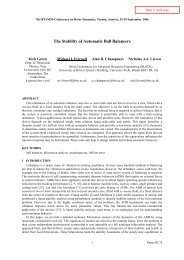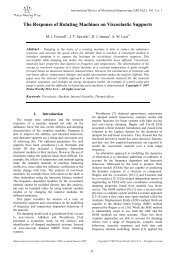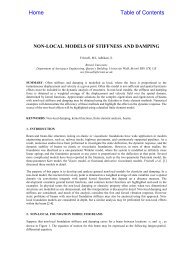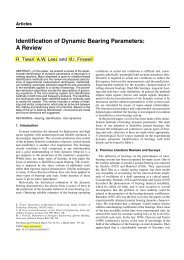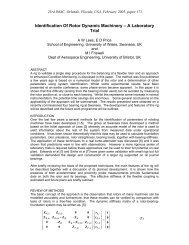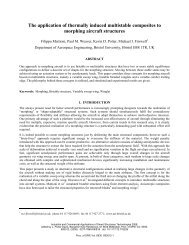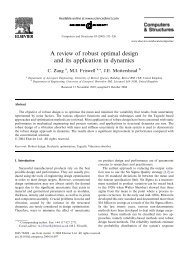Optimal Design of Elastomer Composites for ... - Michael I Friswell
Optimal Design of Elastomer Composites for ... - Michael I Friswell
Optimal Design of Elastomer Composites for ... - Michael I Friswell
Create successful ePaper yourself
Turn your PDF publications into a flip-book with our unique Google optimized e-Paper software.
the SMPs have following disadvantages <strong>for</strong> a large scale wing<br />
morphing [2]: 1) Electrical heating <strong>of</strong> the SMP skin to reach<br />
transition temperature can be difficult. 2) The time required <strong>for</strong><br />
heating SMP material to transition can be ill-suited to dynamic<br />
control morphing objectives. 3) A temperature dependent morphing<br />
mechanism in aircraft wings which are filled with fuels<br />
could be catastrophic.<br />
<strong>Elastomer</strong>ic materials can be ideal candidates <strong>for</strong> the morphing<br />
skin applications [3]. High strain capability, lower degree <strong>of</strong><br />
risk due to their passive operation, elastic recovery with nominal<br />
strain values and a smooth aerodynamic surface <strong>of</strong> elastomers<br />
are advantageous <strong>for</strong> morphing skins. These materials include<br />
thermoplastic polyurethanes, copolyester elastomer, and woven<br />
materials made from elastane yarns. A very few studies have<br />
investigated the elastomeric skins tailored specifically <strong>for</strong> spanmorphing<br />
applications with a suitable supporting substructure to<br />
withstand aerodynamic loads.<br />
Peel et al. [3] developed a wing skin, actuator, and actuator<br />
attachment <strong>for</strong> a simple morphing wing. Upper and lower<br />
wing skins were fabricated with carbon fiber/polyurethane elastomer<br />
laminates. Three pneumatic rubber muscle actuators were<br />
used to provide the required actuation. An elastic camber down<br />
<strong>of</strong> 25 o at the nose and 20 o at the tail were achieved. Bubert et<br />
al. [2] studied the properties <strong>of</strong> various silicone elastomers <strong>for</strong><br />
the morphing skins. The most promising silicone elastomer was<br />
Rhodorsils V-330 CA-45 which had the right combination <strong>of</strong><br />
low viscosity and long work time to enable easy and effective<br />
fiber-rein<strong>for</strong>ced elastomer composite (FMC) manufacture, and<br />
demonstrated high maximum elongation and tear strength.<br />
Kikuta [4] investigated the mechanical properties <strong>of</strong> elastomers<br />
that could be used as a skin <strong>for</strong> morphing wings. The<br />
materials tested were thermoplastic polyurethanes, copolyester<br />
elastomer, woven materials and shape memory polymers. The<br />
materials which strained well and required less <strong>for</strong>ce, could not<br />
sustain high pressure loads. The materials that did not strain<br />
well and required more actuation <strong>for</strong>ce were able to handle a<br />
larger sustained pressure load. Finally, the study suggested that<br />
Tec<strong>of</strong>lex 80A was the best elastomer <strong>for</strong> morphing skin applications.<br />
Another key area <strong>of</strong> research is the design and optimization<br />
<strong>of</strong> laminates <strong>for</strong> morphing applications. With the conflicting objectives<br />
<strong>of</strong> low in-plane stiffness, high out-<strong>of</strong>-plane bending stiffness<br />
and zero Poisson’s ratio, the nature <strong>of</strong> design variables selected<br />
<strong>for</strong> optimization has to be different from that <strong>of</strong> conventional<br />
composite structures. For example, the conventional composite<br />
laminates are made <strong>of</strong> plies with the fibers being straight,<br />
parallel and uni<strong>for</strong>mly spaced. However, <strong>for</strong> a morphing skin<br />
application, the curvilinear fiber-<strong>for</strong>mat, termed as variable stiffness<br />
laminates, can be beneficial as it can decouple the conflicting<br />
requirements <strong>of</strong> morphing skins. Gurdal et al. [5] demonstrated<br />
that the variable stiffness concept provides flexibility to<br />
the designer <strong>for</strong> trade-<strong>of</strong>fs between overall panel stiffness and<br />
buckling load, in that there exist many configurations with equal<br />
buckling loads yet different global stiffness values, or vice versa.<br />
Similar to the curvilinear fiber orientations, another important<br />
parameter is the volume fraction <strong>of</strong> fibers in a composite<br />
laminate. Martin and Leissa [6] investigated the plane stress<br />
problem <strong>of</strong> a composite laminate with spatially varying volume<br />
fractions <strong>of</strong> fibers. The fiber redistribution increased the buckling<br />
load by as much as 38%. Benatta et al. [7] demonstrated the<br />
improvements in the structural properties <strong>of</strong> beams by creating<br />
functionally graded materials (FGM) in the <strong>for</strong>m <strong>of</strong> a symmetric<br />
composite whose fiber volume fraction varies through the thickness.<br />
Kuo and Shiau [8] studied the buckling and vibration <strong>of</strong><br />
composite laminated plates with variable fiber spacing using the<br />
finite element method. The results indicated that more fibers distributed<br />
in the central portion <strong>of</strong> the plate can efficiently increase<br />
the buckling load and natural frequencies. Most <strong>of</strong> these studies<br />
have focussed on the vibration and buckling per<strong>for</strong>mance <strong>of</strong><br />
laminates. However, the same design parameters <strong>of</strong> curvilinear<br />
fibers and variable volume fraction <strong>of</strong> fibers can also be used to<br />
achieve some <strong>of</strong> the design requirements <strong>of</strong> morphing skins, and<br />
is the aim <strong>of</strong> this study. In this work, two essential features <strong>of</strong><br />
morphing skins are studied. In the first part, the optimal combination<br />
<strong>of</strong> fiber and elastomer matrix available <strong>for</strong> morphing wing<br />
skins are studied. The second part involves an optimization process<br />
to find the optimal distribution <strong>of</strong> volume fraction <strong>of</strong> fibers<br />
in a laminate to minimize the in-plane stiffness and maximize the<br />
out-<strong>of</strong>-plane stiffness, simultaneously.<br />
ELASTOMER MATERIAL SELECTION<br />
The wing span extension type morphing mechanisms require<br />
the in-plane stretching <strong>of</strong> wing skins to be more than 25% strain<br />
without failure. Conventional fiber rein<strong>for</strong>ced epoxy laminates<br />
have tensile failure strains in the range <strong>of</strong> 1 to 2% in the fiber direction<br />
and transverse tensile failure strains <strong>of</strong> around 0.5% [9].<br />
The elastomers are one <strong>of</strong> the few materials that can undergo<br />
strains more than 25% without failure. In this section, the lamina<br />
material properties are studied with various elastomers as the<br />
matrix and fibers available in the literature.<br />
The lamina properties are evaluated with a micromechanical<br />
model based on the rule <strong>of</strong> mixtures [10]. This study<br />
finds optimal material properties and highlights issues related to<br />
the design <strong>of</strong> fiber rein<strong>for</strong>ced elastomer laminates. The fibers<br />
and elastomer material properties collected from the literature<br />
are given in Tables 1 and 2. The graphite and kevlar fibers are<br />
transversely isotropic and the glass, boron, and silicon fibers<br />
are isotropic. However, the elastomer laminate stiffness, similar<br />
to the epoxy laminates, are controlled by the longitudinal<br />
modulus <strong>of</strong> the fibers rather than its transverse modulus properties.<br />
The combination <strong>of</strong> longitudinal modulus and Poisson’s<br />
ratio can play a major role in selecting the fibers <strong>for</strong> a morphing<br />
skin. The elastomeric material properties are collected from<br />
2 Copyright c⃝ 2011 by ASME




